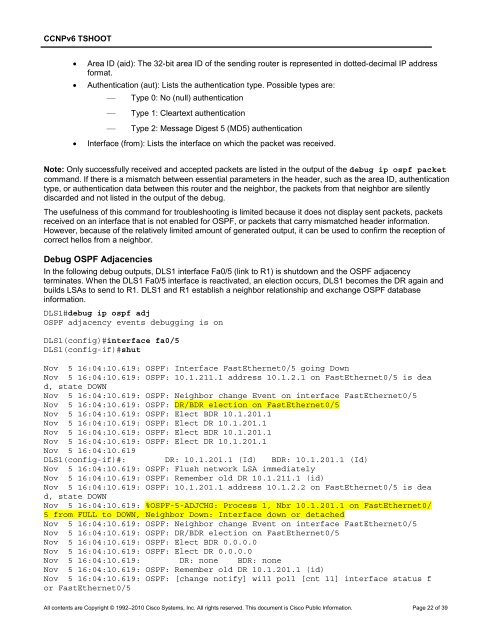CCNP TSHOOT 6.0 - The Cisco Learning Network
CCNP TSHOOT 6.0 - The Cisco Learning Network
CCNP TSHOOT 6.0 - The Cisco Learning Network
You also want an ePaper? Increase the reach of your titles
YUMPU automatically turns print PDFs into web optimized ePapers that Google loves.
<strong>CCNP</strong>v6 <strong>TSHOOT</strong><br />
• Area ID (aid): <strong>The</strong> 32-bit area ID of the sending router is represented in dotted-decimal IP address<br />
format.<br />
• Authentication (aut): Lists the authentication type. Possible types are:<br />
— Type 0: No (null) authentication<br />
— Type 1: Cleartext authentication<br />
— Type 2: Message Digest 5 (MD5) authentication<br />
• Interface (from): Lists the interface on which the packet was received.<br />
Note: Only successfully received and accepted packets are listed in the output of the debug ip ospf packet<br />
command. If there is a mismatch between essential parameters in the header, such as the area ID, authentication<br />
type, or authentication data between this router and the neighbor, the packets from that neighbor are silently<br />
discarded and not listed in the output of the debug.<br />
<strong>The</strong> usefulness of this command for troubleshooting is limited because it does not display sent packets, packets<br />
received on an interface that is not enabled for OSPF, or packets that carry mismatched header information.<br />
However, because of the relatively limited amount of generated output, it can be used to confirm the reception of<br />
correct hellos from a neighbor.<br />
Debug OSPF Adjacencies<br />
In the following debug outputs, DLS1 interface Fa0/5 (link to R1) is shutdown and the OSPF adjacency<br />
terminates. When the DLS1 Fa0/5 interface is reactivated, an election occurs, DLS1 becomes the DR again and<br />
builds LSAs to send to R1. DLS1 and R1 establish a neighbor relationship and exchange OSPF database<br />
information.<br />
DLS1#debug ip ospf adj<br />
OSPF adjacency events debugging is on<br />
DLS1(config)#interface fa0/5<br />
DLS1(config-if)#shut<br />
Nov 5 16:04:10.619: OSPF: Interface FastEthernet0/5 going Down<br />
Nov 5 16:04:10.619: OSPF: 10.1.211.1 address 10.1.2.1 on FastEthernet0/5 is dea<br />
d, state DOWN<br />
Nov 5 16:04:10.619: OSPF: Neighbor change Event on interface FastEthernet0/5<br />
Nov 5 16:04:10.619: OSPF: DR/BDR election on FastEthernet0/5<br />
Nov 5 16:04:10.619: OSPF: Elect BDR 10.1.201.1<br />
Nov 5 16:04:10.619: OSPF: Elect DR 10.1.201.1<br />
Nov 5 16:04:10.619: OSPF: Elect BDR 10.1.201.1<br />
Nov 5 16:04:10.619: OSPF: Elect DR 10.1.201.1<br />
Nov 5 16:04:10.619<br />
DLS1(config-if)#: DR: 10.1.201.1 (Id) BDR: 10.1.201.1 (Id)<br />
Nov 5 16:04:10.619: OSPF: Flush network LSA immediately<br />
Nov 5 16:04:10.619: OSPF: Remember old DR 10.1.211.1 (id)<br />
Nov 5 16:04:10.619: OSPF: 10.1.201.1 address 10.1.2.2 on FastEthernet0/5 is dea<br />
d, state DOWN<br />
Nov 5 16:04:10.619: %OSPF-5-ADJCHG: Process 1, Nbr 10.1.201.1 on FastEthernet0/<br />
5 from FULL to DOWN, Neighbor Down: Interface down or detached<br />
Nov 5 16:04:10.619: OSPF: Neighbor change Event on interface FastEthernet0/5<br />
Nov 5 16:04:10.619: OSPF: DR/BDR election on FastEthernet0/5<br />
Nov 5 16:04:10.619: OSPF: Elect BDR 0.0.0.0<br />
Nov 5 16:04:10.619: OSPF: Elect DR 0.0.0.0<br />
Nov 5 16:04:10.619: DR: none BDR: none<br />
Nov 5 16:04:10.619: OSPF: Remember old DR 10.1.201.1 (id)<br />
Nov 5 16:04:10.619: OSPF: [change notify] will poll [cnt 11] interface status f<br />
or FastEthernet0/5<br />
All contents are Copyright © 1992–2010 <strong>Cisco</strong> Systems, Inc. All rights reserved. This document is <strong>Cisco</strong> Public Information. Page 22 of 39

















